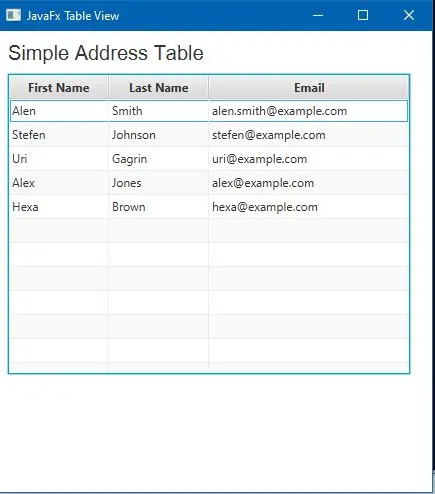setCellValueFactory-Methode in JavaFX

TableView ist ein sehr wichtiger Bestandteil jeder Benutzeroberfläche; Es hilft, Daten für Benutzer zu visualisieren. Bei der Arbeit mit der Tabelle verwenden wir die gebräuchlichste Methode, setCellValueFactory(), um eine Zelle in der Tabelle zu erstellen.
In diesem Artikel werden wir diese Methode diskutieren und ein Beispiel mit einer Erklärung sehen.
Verwenden Sie die setCellValueFactory-Methode in JavaFX
In unserem Beispiel unten haben wir eine einfache Tabelle mit einigen Daten erstellt. Der Code für unser Beispiel sieht wie folgt aus.
// Importing all necessary packages
import javafx.application.Application;
import javafx.beans.property.*;
import javafx.collections.*;
import javafx.event.*;
import javafx.geometry.Insets;
import javafx.scene.*;
import javafx.scene.control.*;
import javafx.scene.control.cell.PropertyValueFactory;
import javafx.scene.layout.VBox;
import javafx.scene.text.Font;
import javafx.stage.Stage;
public class FXtable extends Application {
private TableView table = new TableView(); // Creating a table with a static class "Person"
private final ObservableList data =
FXCollections.observableArrayList(); // Creating an observable list
private void initData() { // Method that set data to table
data.setAll(
// All table datas
new Person("Alen", "Smith", "alen.smith@example.com"),
new Person("Stefen", "Johnson", "stefen@example.com"),
new Person("Uri", "Gagrin", "uri@example.com"),
new Person("Alex", "Jones", "alex@example.com"),
new Person("Hexa", "Brown", "hexa@example.com"));
}
public void start(Stage stage) {
initData(); // Set initial data to table
stage.setTitle("JavaFx Table View"); // Set the title of the table
stage.setWidth(450); // Set the width
stage.setHeight(500); // Set the height
Label label = new Label("Simple Address Table"); // Create a label
label.setFont(new Font("Arial", 20)); // Set the font and font size
TableColumn FirstNameCol = new TableColumn("First Name"); // Create a column named "First Name"
FirstNameCol.setMinWidth(100); // Set the minimum column width to 100
FirstNameCol.setCellValueFactory(
new PropertyValueFactory("firstName")); // Populate all the column data for "First Name"
TableColumn LastNameCol = new TableColumn("Last Name"); // Create a column named "Last Name"
LastNameCol.setMinWidth(100); // Set the minimum column width to 100
LastNameCol.setCellValueFactory(
new PropertyValueFactory("lastName")); // Populate all the column data for "Last Name"
TableColumn EmailColl = new TableColumn("Email"); // Create a column named "Email"
EmailColl.setMinWidth(200); // Set the minimum column width to 200
EmailColl.setCellValueFactory(
new PropertyValueFactory("email")); // Populate all the column data for "Last Name"
table.setItems(data);
table.getColumns().addAll(FirstNameCol, LastNameCol, EmailColl); // Add columns to table
table.setPrefHeight(300); // Set table height
final VBox vbox = new VBox(10); // Create a VBox
vbox.setPadding(new Insets(10, 0, 0, 10)); // Add padding
vbox.getChildren().addAll(label, table); // Organize the VBox with label and table
stage.setScene(new Scene(new Group(vbox))); // Add the VBox to scene
stage.show(); // Visualize the scene
}
public static class Person { // Class for creating the person table
private StringProperty FirstName;
private StringProperty LastName;
private StringProperty email;
private Person(String FName, String LName, String email) {
this.FirstName = new SimpleStringProperty(FName);
this.LastName = new SimpleStringProperty(LName);
this.email = new SimpleStringProperty(email);
}
public String getFirstName() { // Method to get First Name
return FirstName.get();
}
public void setFirstName(String FName) { // Method to set First Name
FirstName.set(FName);
}
public StringProperty FirstNameProperty() { // Method to add First Name property
return FirstName;
}
public String getLastName() { // Method to get Last Name
return LastName.get();
}
public void setLastName(String LName) { // Method to set Last Name
LastName.set(LName);
}
public StringProperty lastNameProperty() { // Method to add Last Name property
return LastName;
}
public String getEmail() { // Method to get Email
return email.get();
}
public void setEmail(String inMail) { // Method to set Email
email.set(inMail);
}
public StringProperty emailProperty() { // Method to add Email property
return email;
}
}
public static void main(String[] args) {
launch(args);
} // Launch the application.
}
Wir haben bereits im Code den Zweck jeder Zeile kommentiert. Jetzt werden wir hier nur über die Funktion setCellValueFactory() sprechen.
Durch die Zeilen FirstNameCol.setCellValueFactory(new PropertyValueFactory("firstName"));, LastNameCol.setCellValueFactory(new PropertyValueFactory("lastName")); und EmailColl.setCellValueFactory(new PropertyValueFactory("email")); haben wir die Methode setCellValueFactory() zum Erstellen von Zellen in unserer Tabelle verwendet.
Hier haben wir drei Spalten namens firstName, lastName und email erstellt. Diese Methode gibt an, wie die Zellen einer Tabelle innerhalb einer einzelnen Tabellenspalte gefüllt werden.
Es stellt die Instanz TableColumn.CellDataFeatures bereit und gibt die Instanz ObservableValue zurück. Nachdem Sie den obigen Beispielcode kompiliert und in Ihrer Umgebung ausgeführt haben, erhalten Sie die folgende Ausgabe.
Ausgang:

Denken Sie daran, wenn Ihre IDE das automatische Einschließen von Bibliotheken und Paketen nicht unterstützt, müssen Sie diese erforderlichen Bibliotheken und Pakete möglicherweise vor dem Kompilieren manuell einschließen.
Aminul Is an Expert Technical Writer and Full-Stack Developer. He has hands-on working experience on numerous Developer Platforms and SAAS startups. He is highly skilled in numerous Programming languages and Frameworks. He can write professional technical articles like Reviews, Programming, Documentation, SOP, User manual, Whitepaper, etc.
LinkedIn